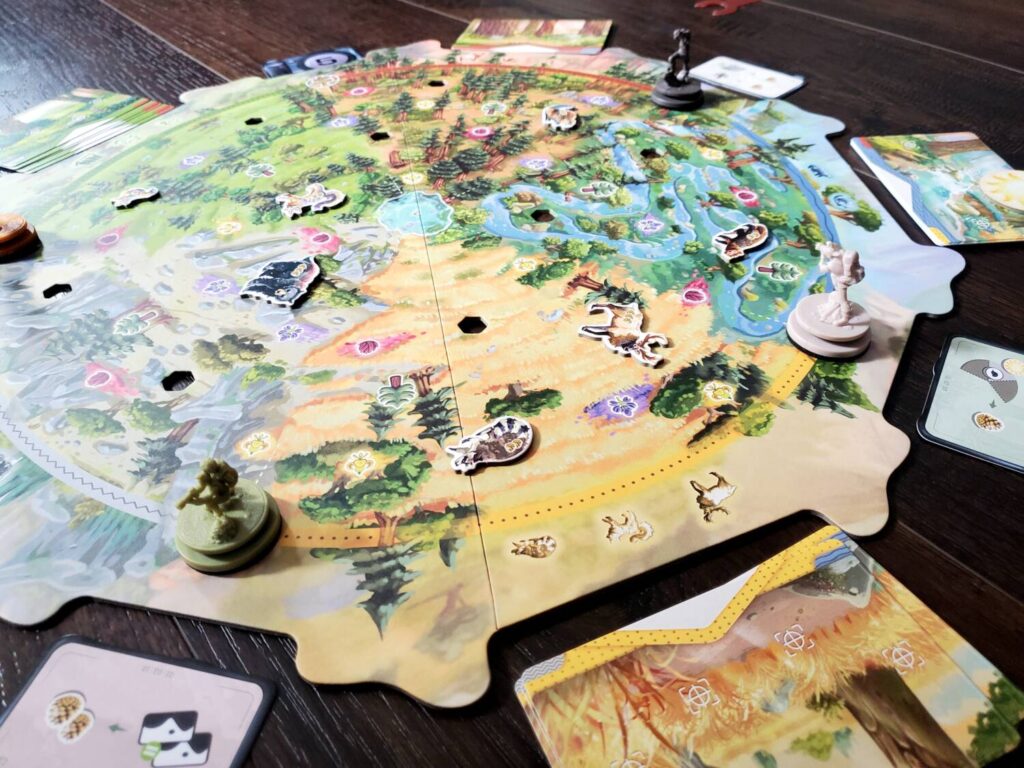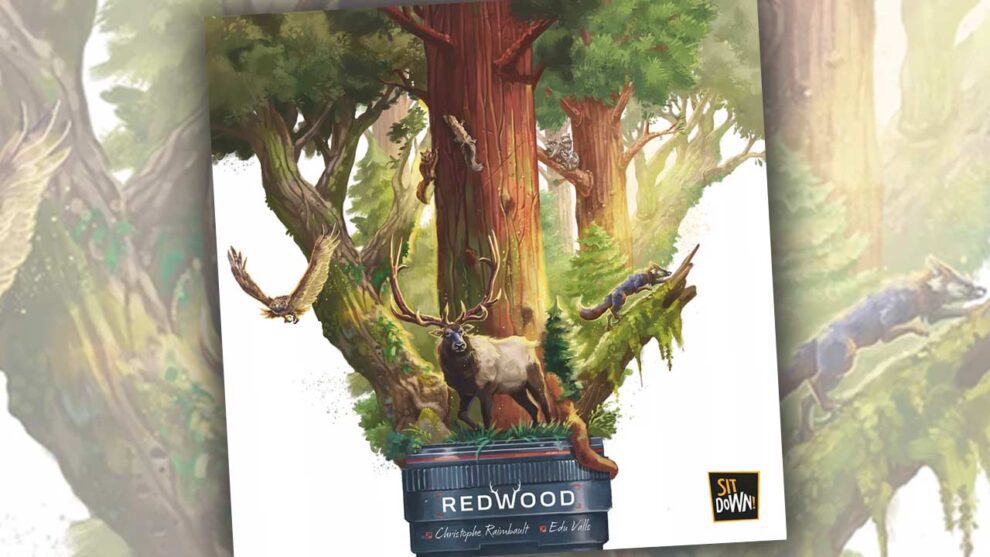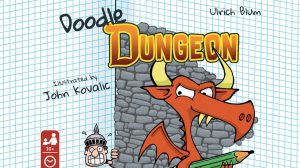Disclosure: Meeple Mountain received a free copy of this product in exchange for an honest, unbiased review. This review is not intended to be an endorsement.
Before affixing my critical goggles in place, I will say from the beginning: Redwood has been one of the most refreshing titles to hit our table in months. Christophe Raimbault’s (Colt Express) design takes the occasional monotony of board game acquisition by the ears and tosses it out on the doorstep with style. I do not know what inspired him to reassign the mechanics of a wargame for use with nature photography, but it just works. Redwood utilizes templates—components of specific shape and size—both for movement and a wholly different sort of shooting, creating a fairly immersive experience. Refreshing. It’s refreshing.
Sing as you raise your bow
The game is an exercise in spatial estimation. Players select two templates under a strict look-but-don’t-touch restriction, one a ribbon for movement, the other a range-finder for their camera lens. The rules make no explicit prohibition of the ol’ thumb-and-forefinger measurement, but exploiting that technicality saps the game of its most thrilling anticipations. Redwood’s distinct pleasure is in the success and failure of the eyes—and only the eyes—in predicting possibilities.

Having committed to the template, players then employ their selections, first moving the photographer into place, then capturing the moment, which is occasionally only the shattered dream of the intended moment, on film. The board is divided into a panorama of backdrops and littered with flowers, trees, and mobile animals. Players take the card at which they have aimed and tokens representing the objects their shot template covers. And thus a photograph is born.
Of course, there must be scoring. Animals give a set number of points along with a bonus based on the variety captured. Flowers and trees give points apiece. The panorama cards provide a score if they are strung together in proper order throughout the game. And then there are harmony tokens, conifer cones assigned based on an increasing number of objectives and a bit of arbitrary fortune.

Redwood takes place over five rounds. With each round, an objective card introduces new possibilities for scoring. “Perfect shots” involve capturing objects in tiny punch holes in the templates. Other objectives suggest the placement of the photographer, the use of specific templates, the aim of the shot, or even reward certain failures. By that final round, there are a half-dozen considerations confounding players’ attempts to suss the value of a shot.
Players hold their templates between turns, creating another arbitrary opening for points. If a player wants to claim a template from an opponent, the bank issues a crisp, cool cone for their forethought. Because the use of certain templates will grant a bonus, the little plastic strips become a battleground all their own.
The expert mode ramps up precision for the truly daring. Panorama cards flip to contain spaces with specific requirements and harsher penalties for failure. Flowers no longer give points apiece, but instead give many more points for each complete set. These adjustments are all about the management of risks and rewards.
Shoot straighter than before
I was in no way looking forward to the four-player affair. The rules recommend a team game in which players work simultaneously with their teammate to pull off their individual shots. It sounded clunky and claustrophobic, a lamentable excuse to alleviate slow play. I was right about the claustrophobia. I was totally wrong in my lack of enthusiasm.
The team game is spectacular. These are wargame mechanics. There’s something satisfying about strategizing over the range of possibilities and the round’s finest opportunities. Talking over the templates, which ones will work (which, despite four eyes and two brains, don’t) and which ones clearly won’t (which, in retrospect, would have) is where Redwood unexpectedly shines. The table is full of chatter, and every conversation involves a hesitant commitment, groans of disappointment, yelps of glee, fist bumps, and celebrations.
For crying out loud, we were trash-talking over a photography game.
Redwood is interesting as a multi-player endeavor, but it is truly refreshing as a team experience. In fact, I might be so bold as to say this little photography game is my favorite cooperative play to date. Quarterbacking is off the table. This is non-war, people! Conversation abounds, but every one must own their own decisions, lay hold of their templates, and deal with the consequences. And yet, we were entirely together in the effort.

Because it is non-war, Redwood carries an air of simple pleasure. It’s fun getting in the opposition’s way, moving the animals in an attempt to spoil their upcoming shot, and then watching the scramble. Even better, it’s fun to celebrate their ingenuity in capturing the very thing you tried so hard to impede.
Perhaps one of the reasons I’m so enamored with these mechanics, which are by no means innovative, is that they come from a genre that really has little appeal for me. I am not a wargamer, nor am I well-versed in skirmish-style miniatures, map movement, or point-and-shoot titles. Raimbault has managed to package a manner of play that is otherwise foreign to me into a relevant and accessible setting. As I’ve already said, it’s refreshing.
Bring the balance back
Redwood is gorgeous. I am playing the retail edition and it’s gorgeous. The photographers have neoprene padding to help hold them in place while fitting the templates. Sadly, the board does not have neoprene padding so it knocks about the surrounding cards at times. The cards are pretty. The tokens are clear from across the table. The animals are marked with points on one side, but you can leave that information face-down until the end just to maintain the aesthetic.

The templates seem sturdy enough to withstand play. The movement templates are poorly marked with pips, but it’s easy enough to know whether you’ve got the one that will score you points. Even the shoelace that’s used to determine the shot’s panoramic aim is worthy of a Columbia boot. The box, too, is sturdy and beautiful. I’ve only heard hyperbolic things about the grandeur of the deluxe version if big boxes are your thing. As for me and my house, we skip the super-size in exchange for simplicity and speedy setup.
Gameplay can be slow and dubious depending on the players, but Redwood is the sort of game that invites all sorts to the table. While the adults were enamored, even our youngest, at six years old, adores the whole package. Just remember, it’s non-war. There’s no need to ream out the kids if their photographer slips a millimeter while removing the template. Nations won’t fall if someone claims a squirrel even though the slightest sliver of white was showing on the edge of the template. Then again, if you’ve got an intense group at the table, maybe you want to act as though they will.
Redwood is not wholly new, and I suspect there is a limit to its depth. After all, it’s merely a set collection game at heart; but that’s what makes it so engaging. It’s a clever manner of collecting, a twist on the familiar, and a whiff of battle, that makes it an ideal change of pace for a guy like me.












Add Comment